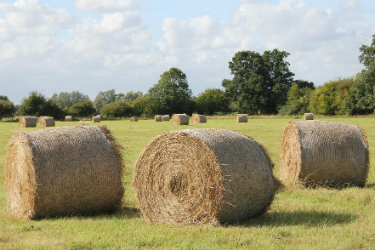Helping Equine Clients Choose High Quality Forages

Horses need forage to keep their digestive tract healthy and to maintain gut motility. On average, a horse weighing 1000 pounds will eat between 10 to 20 pounds of baled or cured hay per day, which means they will eat through a lot of hay in their lifetime. Their providers, your clients, need to know what to look for in order to wisely choose the hay they feed to their animals.
Types of Forage
There are two basic kinds of forages that are used to feed horses:
- Grasses
- Legumes
Hays that are often fed to horses include:
- Grass hay:
- Orchard
- Timothy
- Tall fescue
- Kentucky bluegrass
- Brome
- Legume hay:
- Alfalfa
- Red clover
- Ladino clover
- Birdsfoot trefoil
In a quick comparison of the two types:
- Depending on the time of harvest, grass hays are typically lower in protein, calcium, and phosphorous when compared to legume hays
- Grass hays or grass and alfalfa mixed hays are usually considered to meet the nutritional needs for most mature, idle, or light work horses
- The higher protein level in legume hay makes it a choice to consider for animals that are still growing
Caution: Mineral Imbalance
As stated earlier, grass hays are lower in calcium and phosphorous, but the two minerals are in a correct ratio. In legumes these minerals are higher, but the ratio is incorrect. While older horses can tolerate the higher levels, growing animals can’t and may develop bone abnormalities. Clients need to be aware of the potential mineral imbalance when feeding straight legumes, and be advised of ways to balance the forage with an appropriate salt/mineral mix.
Caution: Silage
Both grasses and legumes can be made into silage, but because it has a tendency to mold, it is not recommended to feed silage to horses.
Choosing a Hay
After deciding between grass and legume, the next step taken involves determining the quality of a hay. Evaluating hay quality by using the organoleptic (sensory) analysis method can be a simple tool to share with clients. This method looks at the following five categories:
- Maturity
- As hay increases in maturity it decreases in digestibility and nutritional value
- Legumes in full bloom or large grass seed heads indicate lower feed value
- To evaluate its maturity look for the following:
- Coarseness and brittleness of stems
- Development of the seed head
- Leafiness
- Leaves hold most of the highly digestible protein and nutritional value
- To evaluate:
- Look for leafy hays
- Avoid hays that are mostly stems or have shattered leaves
- Condition
- This category is revealed by sight, smell, and feel
- If hay is baled too green it will become very hot which will decrease the protein
- If baled too green the curing process will be damaged and the hay will mold or become dusty
- To evaluate:
- Sight and smell:
- Examine for mold and dust
- Feel:
- Check to determine for brittleness and heat
- Color
- Look for green hay which indicates the Vitamin A content and shows that the hay was not rained on before being baled
- Note: The lower nutritional value in hay that has been slightly rained on is usually due to leaf loss because it had to be handled more in order to dry sufficiently before baling
- Foreign Material
- Weeds and foreign materials in hay lower its nutritional value
The choice of forage is important. Clients that know how to determine between bales of bright, clean and fresh hay and bales that are of lower quality will be able to better provide their animal with the nutritional diet they need.
Learn more about selecting the right foods for your client’s animals by contacting your Covetrus representative today at 855.724.3461!
Information gathered from:
http://www.thehorse.com/articles/36357/forage-evaluating-quality-and-balancing-rations
http://extension.usu.edu/files/publications/publication/AG_Equine_2006-02.pdf
Horse Nutrition
Bulletin 762
The Ohio State University Extension
Copyright 2000
Need Regulatory Assistance
If you need help with regulatory or licensing issues, we're happy to help. We have a wide variety of resources to help you when issues arise.

Careers
Are you looking for a place to let your talents shine? At Covetrus, we help our practitioner customers better serve their patients and take pride in providing the best customer experience possible. Search our open positions to see our available opportunities.
Newsletter
Stay current with what’s going on with Covetrus, subscribe to receive our newsletter and email communications. Subscribers will receive the latest information in practice management, sales and marketing, animal health, and more.


Leave a comment